THE BFS READINESS PROGRAMIs 7th Grade Too Early To Begin Training? How Do I Implement a Weight Training Program? What Should My Jr. High Athlete Do In The Weightroom? Junior High School athletes can benefit from the advantaBy Greg Shepard Published: Spring 2000 The Bigger Faster Stronger Readiness Program is a weightlifting program which BFS has taught for over 15 years. It is designed for the beginning, junior high or middle school athlete from as young as the 7th grade. It can produce spectacular results in practically any environment for both boys and girls of all athletic abilities. It can be implemented in a physical education class or as an entity unto itself. The benefits from this program are astounding to see and are fun to coach. The Readiness Program is designed specifically for the athlete. We are not body building or competitive lifting; these are entirely different kinds of training done in the weight room. The goal is to get bigger, faster and stronger. We also want to jump higher and farther with increased endurance, agility, flexibility while being less injury prone. However, our highest goal is simply to WIN in our respective sport. The BFS Readiness Program introduces free weights, which nearly all athletes use as their major emphasis of training. Free weights have proved far superior to any kind of machine when it comes to explosive power and total body strength. Progress, self-concept and a spirit of competition are also developed in a superior fashion with free weights. The BFS Readiness Program uses most of the Core Lifts as in the BFS Total Program, which are The Squat, The Bench, The Clean & variations such as the Towel Bench and The Box Squat, as well as auxiliary exercises. Each lift is done with perfect form for two sets of ten reps, except the Power Clean which is done two sets of only five reps. If you do not have a Hex Bar, do the Straight Leg Dead Lift but never use more than 55 pounds and do two sets of ten reps. The Readiness Program consists of two different power movements on each of three different workouts per week (see chart). There is also a variation for a two workout schedule. In the first two months three core lifts can actually be done in less than twenty minutes. All athletes from all sports are to do the Core Lifts. Then, if time and energy permits, several auxiliary exercises can be selected. Auxiliary exercises are based on “How will this exercise help me win.” For example, football players and wrestler’s would really emphasize neck exercises; while basketball players would emphasize other exercises. On Tuesday’s and Thursday’s athletes work on sprinting technique, conditioning, agility -such as the BFS Dot Drill & technique specific to his or her sport such as throwing a football, shooting free throws or setting the ball. Many coaches and parents may be confused as to what to do with their athletes that show an interest in athletics. Should my athlete weight train? What should he/she do? Is 7th grade too early? It it really safe? The questions are real. It is important, we feel that they get answered. IS 7TH GRADE TOO EARLY? Absolutely not! Not if you do it right. Consider that about 75% of all junior boys have been given a weight set for Christmas or a birthday with no clue on how to use it. I believe junior high and middle schools have a responsibility to teach all aspects of strength and conditioning correctly. Certainly teaching agility, speed and jumping techniques should not be open for debate. These are important aspects of a total strength and conditioning program. Athletes or general physical education students in the 7th Grade may begin this program. We realize that some orthopedic surgeons may say this is too early to start any kind of weight training. They might say that because the bones have not completely hardened, a problem might occur. However, after careful study, thought and observation of young athletes who do weight train, we feel the benefits far outweigh any possible risks. First of all, we are in the business of helping athletes and people reach their potential and without weight training this is virtually impossible. A study on 7th graders weight training has drawn preliminary conclusions that no interference of bone growth resulted from weight training. Dr. Mel Hayashi, a noted orthopedic surgeon from Thousand Oaks, California, states “The BFS Readiness Program should provide great benefits to the junior high athlete. I have no concerns as long as the athlete has good technique.” Dr. Hayashi has been a chief orthopedic surgeon at the past Olympic Games and has been a chief resident at the Mayo Clinic. Many strength coaches of major universities throughout the nation have been asked when an athlete should start weight training. The vast majority responded: “In Junior High.” The Eastern Bloc countries start their athletes' weight training at the age of 12. In addition, we know weight training is one of the greatest ways to build self-confidence and self esteem. A seventh grader can receive just as much satisfaction going from 85 pounds to 100 pounds on his bench as can a 12th grader going from 285 to 300 pounds. However, we also believe strict supervision is a must along with the teaching of proper technique to make the BFS Readiness Program work in the Junior High. Programs like the BFS Readiness Program are completely endorsed and approved by the National Strength Coaches Association. HOW DO I GET STARTED WITH THE PROGRAM? I have broken down the Readiness program into five sections from Unification to Graduation, but first lets discuss one of the most critical parts of a successful program. UNIFICATION All sports both boys and girls in grades seven through twelve should be on the same strength and conditioning program. In the vast majority of schools every sport does their own thing. Invariably with the multi-sport athlete this causes confusion and it is terribly inefficient. Many great dominant football programs have all grade levels use the same system of offense, defense and terms. A dominant strength and conditioning program should be the same way. All coaches should use the same terms, the same warm-up, the same flexibility, lifting, speed and plyometric program. Begin this concept in the 7th grade with the BFS Readiness Program. GET THE RIGHT EQUIPMENT The BFS Readiness weightlifting program highly recommends several trend-setting pieces of equipment. First, the Aluma-lite bar (15 pounds) and the Ultra-lite bar (30 pounds). These bars are very similar to a regular 45-pound Olympic bar except for the weight. They are designed specifically by BFS for training and learning. Even a smaller 7th grade boy or girl can learn any lift safely and correctly. It is loads of fun for these kids because now they can lift just like the older high school or college kids. They can build explosive power, strength and self-confidence while learning correct athletic positions which can be used in their sport. The second piece of equipment is the BFS Training Plate and the BFS 10 lb. Bumper plate. When doing a Clean or any lift from the floor, the bar needs to be elevated high enough to get into a safe position about 8-9 inches off the floor. This allows for the back to be properly locked-in and the chest spread. By doing this, the athletes are able to place the lifting emphasis on their hips and legs as opposed to their backs and arms. You simply cannot do this with a five or a ten pound steel plate because the bar is barley off the floor causing the athlete to have to bend almost completely over just to pick up the weight. Both BFS Training Plates are the same size as a 45-pound plate. The 5 lb Training plate is about an inch thick and made of very hard urethane, while the 10 lb bumper is about 2 inches thick and made of a softer urethane that gives. This allows for the plates to be dropped as opposed to being set back down. Kids especially love the bright colored 10-pound Bumper plate and the Aluma-lite bar. It looks like 135 pounds but really only weighs 35 pounds. TEACH CORRECT TECHNIQUE |
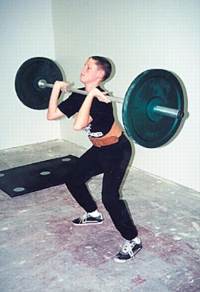 |
|
Mark Shepard, a 13 year old 8th grader, does a Power Clean with perfect form. Here he has a 15 lb. Aluma-Lite bar and 10 lb. Bumper Plates for a total of only 35 lbs! |
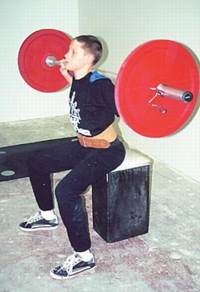 |
|
The Box Squat is by far the easiest way to learn perfect squatting technique. Mark uses a belt for support and the blue Manta Ray to distribute the bar weight. |
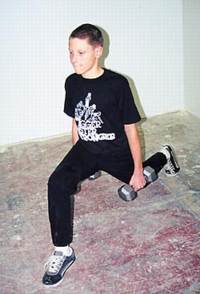 |
|
Lunges develop power balance by strengthening all major muscle groups in the trunk and legs. This is a great auxiliary exercise for all athletes. |
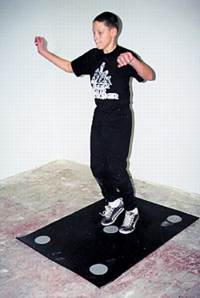 |
|
Agility is important to do everyday. We do the Dot Drill as a warm-up before each workout. |
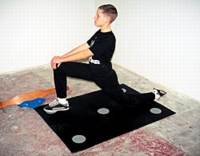 |
|
Here Mark demonstrates the Hip Flexor stretch, part of the BFS 1-2-3-4 flexibility program. Behind Mark is a leather belt and the Manta Ray, which snaps onto any olympic bar and evenly distributes the weight when squatting. |
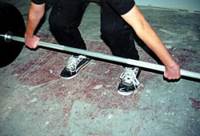 |
|
The Readiness Program teaches the same stance and grip that high school and college athletes are taught. The BFS 5 lb. Training Plates allows the Bar to be eight inches off the floor, this places the athlete in a safe position with a light weight that can easily be lifted. |
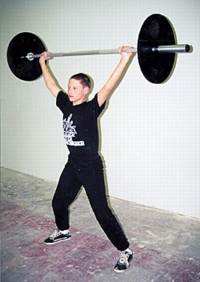 |
|
Mark easily does a Power Snatch with the Aluma-Lite Bar and BFS Training Plates. The entire weight...only 25 lbs. This enables all athletes to learn complex lifts easily. |
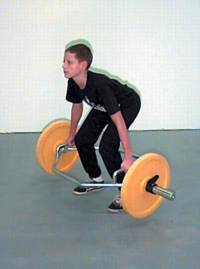 |
|
The Hex Bar takes up little space and is an easy lift to do. Standing in the center of the bar forces the athlete into a correct position. |
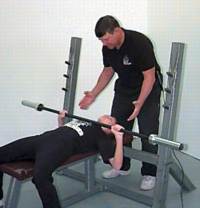 |
|
The Bench press develops chest, arm and shoulder strength. With the Towel Bench, the athlete places a pad (approx 5” thick) on the chest and brings the bar down until it hits the pad then presses it up. This variation on the Bench is easier on the shoulders. |
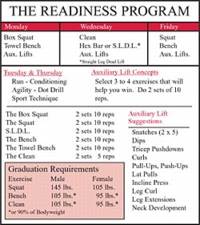 |
|
Readiness Program Overview |